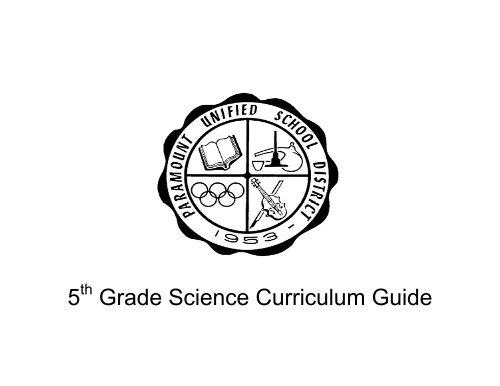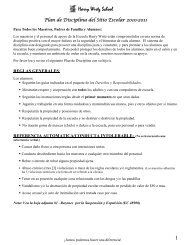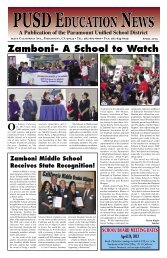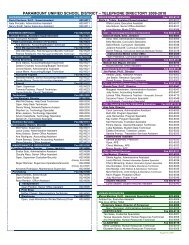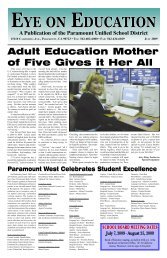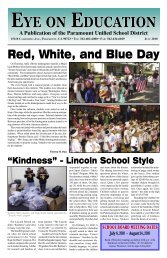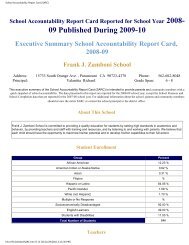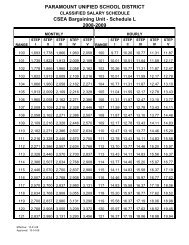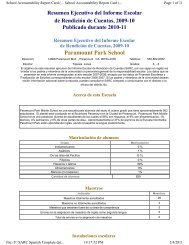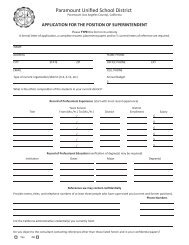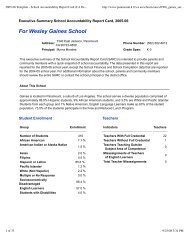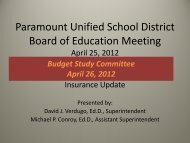Grade 5 Science Curriculum Guide
Grade 5 Science Curriculum Guide
Grade 5 Science Curriculum Guide
Create successful ePaper yourself
Turn your PDF publications into a flip-book with our unique Google optimized e-Paper software.
5 th <strong>Grade</strong> <strong>Science</strong> <strong>Curriculum</strong> <strong>Guide</strong>
5 th <strong>Grade</strong> <strong>Science</strong> Course Outline<br />
Quarter 1<br />
Unit B: Earth <strong>Science</strong> Time Frame: 45 Days<br />
Chapter 4: Water Resources Time Frame: 22 Days<br />
Lesson 1: Where Is Earth’s Water?<br />
Lesson 2: How Do Communities Get Water?<br />
Lesson 3: How Can Fresh Water Be Used Wisely?<br />
Chapter 5: The Water Cycle Time Frame: 22 Days<br />
Lesson 1: How Does Water Change State?<br />
Lesson 2: How Does Precipitation Form?<br />
Lesson 3: How Does The Ocean Affect Weather?<br />
Quarter 2<br />
Unit C: Physical <strong>Science</strong> Time Frame: 45 Days<br />
Chapter 6: Weather Time Frame: 22 Days<br />
Lesson 1: How Does Air Pressure Affect Weather?<br />
Lesson 2: Why Does Air Move?<br />
Lesson 3: How Are Weather Forecasts Made?<br />
Lesson 4: What Causes Storms?<br />
Chapter 7: The Solar System Time Frame: 22 Days<br />
Lesson 1: What Is Earth’s Sun Like?<br />
Lesson 2: What Orbits The Sun?<br />
Lesson 3: What Are The Planets Like?<br />
Lesson 4: What Keeps Planets In Their Orbits?<br />
2
5 th <strong>Grade</strong> <strong>Science</strong> Course Outline (cont.)<br />
Quarter 3<br />
Unit A: Life <strong>Science</strong> Time Frame: 45 Days<br />
Chapter 1: Cells<br />
Lesson 1: What Are The Parts Of A Cell?<br />
Lesson 2: How Do Cells Make And Use Energy?<br />
Lesson 3: How Are Cells Organized?<br />
Time Frame: 15 Days<br />
Chapter 2: Plant Systems Time Frame: 15 Days<br />
Lesson 1: How Do Plants Produce Food?<br />
Lesson 2: How Do Plants Move Materials?<br />
Chapter 3: Human Body Systems Time Frame: 15 Days<br />
Lesson 1: What Are The Respiratory And Circulatory Systems?<br />
Lesson 2: What Is The Digestive System?<br />
Lesson 3: What Is The Excretory System?<br />
Quarter 4<br />
Unit D: Physical <strong>Science</strong> Time Frame: 45 Days<br />
Chapter 8: Atoms and Elements Time Frame: 15 Days<br />
Lesson 1: Atoms And Elements<br />
Lesson 2: What Is The Periodic Table?<br />
Lesson 3: Where Are Elements Found?<br />
Chapter 9: Chemical Compounds Time Frame: 15 Days<br />
Lesson 1: What Are Compounds?<br />
Lesson 2: What Are Some Of The Properties Of Compounds?<br />
Lesson 3: What Are Acids, Bases, And Salts?<br />
3
5 th <strong>Grade</strong> <strong>Science</strong> Course Outline (cont.)<br />
Quarter 4 (cont.)<br />
Unit D: Physical <strong>Science</strong> Time Frame: 45 Days<br />
Chapter 10: Characteristics of Matter Time Frame: 15 Days<br />
Lesson 1: What Are The Three States Of Matter?<br />
Lesson 2: What Are Mixtures And Solutions?<br />
Lesson 3: How Does Matter Change?<br />
Lesson 4: What Happens In A Chemical Reaction?<br />
Key for Textbook Abbreviations Used in <strong>Curriculum</strong> <strong>Guide</strong>lines<br />
TE = Teachers Edition<br />
WB = Student Workbook<br />
URF = Unit Resource Folder<br />
4
Earth <strong>Science</strong><br />
5th <strong>Grade</strong> <strong>Science</strong><br />
Quarter 1 Standards Resources/Teaching Strategies<br />
Unit B 3a. Students know most of Earth's Days 1-7: Where Is Earth’s Water? 3a, 3d<br />
Water water is present as salt water in the<br />
oceans, which cover most of Earth's<br />
Resources<br />
surface.<br />
Chapter 4<br />
22 days<br />
Lesson 1: Where<br />
Is Earth’s Water?<br />
Lesson 2: How<br />
Do Communities<br />
Get Water?<br />
Lesson 3: How<br />
Can Fresh Water<br />
Be Used Wisely?<br />
Resource and<br />
Technology<br />
• Lesson Planner<br />
• Unit Resource<br />
Folder<br />
• Teaching<br />
Transparencies<br />
• Interactive Lab<br />
Video<br />
• National<br />
Geographic<br />
Video<br />
• E <strong>Science</strong> Book<br />
• Vocabulary<br />
games and<br />
cards<br />
3b. Students know when liquid water<br />
evaporates, it turns into water vapor in<br />
the air and can reappear as a liquid<br />
when cooled or as a solid if cooled<br />
below the freezing point of water.<br />
3c. Students know water vapor in the air<br />
moves from one place to another and<br />
can form fog or clouds, which are tiny<br />
droplets of water or ice, and can fall to<br />
Earth as rain, hail, sleet, or snow.<br />
3d. Students know that the amount of<br />
fresh water located in rivers, lakes,<br />
under-ground sources, and glaciers is<br />
limited and that its availability can be<br />
extended by recycling and decreasing<br />
the use of water.<br />
3e. Students know the origin of the<br />
water used by their local communities.<br />
Key Vocabulary<br />
• groundwater<br />
• runoff<br />
• aquifer<br />
• water table<br />
• watershed<br />
• spring<br />
• irrigation<br />
• reservoir<br />
• aqueduct<br />
• well<br />
• water reclamation<br />
Lesson 1<br />
Essential Reading<br />
Water on Earth (pp. 112-117)<br />
Essential Lab<br />
Express Lab Card 9 (TE p. 113)<br />
AND/OR<br />
• WB (pp. 34-37)<br />
• Direct Inquiry (TE pp.110-111)<br />
• Pressed for Time<br />
• Unit Resource Folder (pp. 89-92)<br />
Day 8-14: How Do Communities Get Water? 3d, 3e<br />
Lesson 2<br />
Essential Reading<br />
Water to Everyone (pp. 122-127)<br />
Essential Activity/Lab<br />
Pressed for Time Record (TE p. 121, URF p. 95)<br />
AND/OR<br />
• WB (pp. 38-41)<br />
• Direct Inquiry (TE pp. 120-121)<br />
• Express Lab (p.123)<br />
• Pressed for Time<br />
• Unit Resource Folder (pp. 93-96)<br />
5
Earth <strong>Science</strong><br />
5th <strong>Grade</strong> <strong>Science</strong><br />
Quarter 1 Standards Resources/Teaching Strategies<br />
Unit B<br />
Water<br />
Resources<br />
Chapter 4<br />
22 days<br />
Day 15-21: How Can Fresh Water Be Used? 3d, 3e<br />
Lesson 3: How<br />
Can Fresh<br />
Water Be Used<br />
Wisely<br />
3d. Students know that the amount<br />
Of fresh water located in rivers,<br />
lakes, under-ground sources, and<br />
glaciers is limited and that its<br />
availability can be extended by<br />
recycling and decreasing the use<br />
of water.<br />
3e. Students know the origin of the<br />
water used by their local communities.<br />
Lesson 3<br />
Essential Reading<br />
Conserving Fresh Water (pp. 132-137)<br />
Essential Activity/Lab<br />
Direct Inquiry (TE pp. 130-131)<br />
Recording Sheet (URF pp. 97 - 98)<br />
AND/OR<br />
• WB (pp. 42-45)<br />
• Express Lab Card 11 (TE p.133)<br />
• Pressed for Time<br />
• Unit Resource Folder (pp. 97-100)<br />
Assessment Options<br />
• Pretest (URF)<br />
• Chapter Review and Test Practice (TE pp. 140-141)<br />
• Chapter Benchmark Test (URF)<br />
• Unit Test (URF)<br />
• ExamView software<br />
• CST Practice and Review<br />
Literature<br />
Independent <strong>Science</strong> Books<br />
• Water Resources - Chapter Support<br />
• Niagara Falls - On Level<br />
• Where Does Drinking Water Come From - Challenge<br />
Library Books<br />
• Mountains by Seymour Simon<br />
• The Kingfisher Young People’s Book of Planet Earth<br />
• by Martin Redfern<br />
6
Earth <strong>Science</strong><br />
5th <strong>Grade</strong> <strong>Science</strong><br />
Quarter 1 Standards Resources/Teaching Strategies<br />
Unit B 3b. Students know when liquid water Days 1-7: How Does Water Change State? 3b, 3c<br />
The Water evaporates, it turns into water vapor in<br />
the air and can reappear as a liquid<br />
Cycle<br />
when cooled or as a solid if cooled<br />
Chapter 5 below the freezing point of water.<br />
22 days<br />
Lesson 1: How<br />
Does Water<br />
Change State?<br />
Lesson 2: How<br />
Does<br />
Precipitation<br />
Form?<br />
Lesson 3: How<br />
Does the Ocean<br />
Affect Weather?<br />
Resource and<br />
Technology<br />
• Lesson Planner<br />
• Unit Resource<br />
Folder<br />
• Teaching<br />
Transparencies<br />
• Interactive Lab<br />
Video<br />
• National<br />
Geographic<br />
Video<br />
• Vocabulary<br />
games and<br />
cards<br />
• E <strong>Science</strong> Book<br />
3c. Students know water vapor in the air<br />
moves from one place to another and<br />
can form fog or clouds, which are tiny<br />
droplets of water or ice, and can fall to<br />
Earth as rain, hail, sleet, or snow.<br />
4a. Students know uneven heating of<br />
Earth causes air movements<br />
(convection currents).<br />
4b. Students know the influence that<br />
the ocean has on the weather and the<br />
role that the water cycle plays in<br />
weather patterns<br />
Key Vocabulary<br />
• condensation<br />
• evaporation<br />
• precipitation<br />
• transpiration<br />
• water vapor<br />
• convection current<br />
• dew point<br />
• humidity<br />
• relative humidity<br />
• ocean current<br />
Lesson 1<br />
Essential Reading<br />
The Water Cycle (TE pp. 148-151)<br />
Essential Lab<br />
Pressed for Time Lab (TE p. 153, URF p. 112)<br />
AND/OR<br />
• WB (pp. 46-49)<br />
• Direct Inquiry (TE pp.146-147)<br />
• Express Lab Card 12 (TE p.149)<br />
• Pressed for Time<br />
• Unit Resource Folder (pp.110-113)<br />
Day 8-14: How Does Precipitation Form? 3b, 3c, 4a<br />
Lesson 2<br />
Essential Reading<br />
Precipitation (TE pp. 154-159)<br />
Essential Activity/Lab<br />
Express Lab Card 13 (URF p. 95)<br />
AND/OR<br />
• WB (pp. 50-53)<br />
• Direct Inquiry (TE pp. 152-153)<br />
• Pressed for Time<br />
• Unit Resource Folder (pp. 114-117)<br />
7
Earth <strong>Science</strong><br />
5th <strong>Grade</strong> <strong>Science</strong><br />
Quarter 1 Standards Resources/Teaching Strategies<br />
Unit B<br />
The Water 4a. Students know uneven heating of<br />
Day 15-21: How Does the Ocean Affect Weather? 4a, 4b<br />
Earth causes air movements<br />
Cycle<br />
(convection currents).<br />
Chapter 5<br />
22 days<br />
Lesson 3: How<br />
Does the Ocean<br />
Affect Weather?<br />
4b. Students know the influence that<br />
the ocean has on the weather and the<br />
role that the water cycle plays in<br />
weather patterns<br />
Lesson 3<br />
Essential Reading<br />
Ocean Effects (pp. 164-167)<br />
Essential Activity/Lab<br />
Express Lab Card 14 (TE p. 165)<br />
AND/OR<br />
• WB (pp. 54-57)<br />
• Direct Inquiry (TE pp. 162-163)<br />
• Pressed for Time<br />
• Unit Resource Folder (pp. 118-121)<br />
Assessment Options<br />
• Pretest (URF)<br />
• Chapter Review and Test Practice (TE pp. 172-175)<br />
• Chapter Bench Test (URF)<br />
• Unit Test (URF)<br />
• ExamView software<br />
• CST Practice and Review<br />
Literature<br />
Independent <strong>Science</strong> Books<br />
• The Water Cycle - Chapter Support<br />
• The End of the Ice Age - On Level<br />
• A Drop of Water - Challenge<br />
Library Books<br />
• Water: Our Precious Resource by Roy A. Gallant<br />
8
Physical<br />
<strong>Science</strong><br />
Quarter 2<br />
Unit C<br />
Weather and<br />
the Solar<br />
System<br />
Chapter 6<br />
22 Days<br />
Lesson 1: How<br />
Does Air<br />
Pressure Affect<br />
Weather?<br />
Lesson 2: Why<br />
Does Air Move?<br />
Lesson 3: How<br />
Are Weather<br />
Forecasts Made?<br />
Lesson 4: What<br />
Causes Storms?<br />
Resources and<br />
Technology<br />
● Lesson Planner<br />
● Unit Resource<br />
Folder<br />
● Teaching<br />
Transparencies<br />
● Interactive Lab<br />
Video<br />
● National<br />
Geographic<br />
Videos<br />
● Vocabulary<br />
Games and<br />
cards<br />
● E <strong>Science</strong> books<br />
Standards<br />
4a. Students know uneven heating of<br />
Earth causes air movements<br />
(convection currents).<br />
4c. Students know the causes and<br />
effects of different types of severe<br />
weather.<br />
4d. Students know how to use weather<br />
maps and data to predict local weather<br />
and know that weather forecasts<br />
depend on many variables.<br />
4e. Students know that the Earth's<br />
atmosphere exerts a pressure that<br />
decreases with distance above Earth's<br />
surface and that at any point it exerts<br />
this pressure equally in all directions.<br />
Key Vocabulary<br />
• air pressure<br />
• tornado<br />
• weather<br />
• atmosphere<br />
• jet stream<br />
• land breeze<br />
• mountain breeze<br />
• planetary winds<br />
• sea breeze<br />
• valley breeze<br />
• air mass<br />
• front<br />
• meteorologist<br />
• blizzard<br />
• hurricane<br />
5th <strong>Grade</strong> <strong>Science</strong><br />
Resources/Teaching Strategies<br />
Days 1-5: How Does Air Pressure Affect Weather? 4a, 4e<br />
Lesson 1<br />
Essential Reading<br />
Earth’s Atmosphere (TE pp. 184-191)<br />
Essential Lab<br />
Express Lab Card 15 (TE p. 187)<br />
AND/OR<br />
• WB (pp. 58-73)<br />
• Direct Inquiry (TE p. 182-183)<br />
• Pressed for Time<br />
• Unit Resource Folder (pp. 143-146)<br />
Days 6-10: Why Does Air Move? 4a, 4e<br />
Lesson 2<br />
Essential Reading<br />
Moving Air (TE 194-199)<br />
Essential Lab<br />
Express Lab Card 16 (TE p. 197)<br />
AND/OR<br />
• WB (pp. 62-65)<br />
• Direct Inquiry (TE pp. 192-193)<br />
• Pressed for Time<br />
• Unit Resource Folder (pp. 147-150)<br />
9
Physical<br />
<strong>Science</strong><br />
Quarter 2<br />
Unit C<br />
Weather and<br />
the Solar<br />
System<br />
Chapter 6<br />
22 Days<br />
Lesson 3: How<br />
are Weather<br />
Forecasts Made?<br />
Lesson 4: What<br />
Causes Storms?<br />
Resources and<br />
Technology<br />
● Lesson Planner<br />
● Unit Resource<br />
Folder<br />
● Teaching<br />
Transparencies<br />
● Interactive Lab<br />
Video<br />
● National<br />
Geographic<br />
Videos<br />
● Vocabulary<br />
Games and<br />
cards<br />
● E <strong>Science</strong><br />
Books<br />
Standards<br />
4a. Students know uneven heating of<br />
Earth causes air movements<br />
(convection currents).<br />
4c. Students know the causes and<br />
effects of different types of severe<br />
weather.<br />
4d. Students know how to use weather<br />
maps and data to predict local weather<br />
and know that weather forecasts<br />
depend on many variables.<br />
4e. Students know that the Earth's<br />
atmosphere exerts a pressure that<br />
decreases with distance above Earth's<br />
surface and that at any point it exerts<br />
this pressure equally in all directions.<br />
5th <strong>Grade</strong> <strong>Science</strong><br />
Resources/Teaching Strategies<br />
Days 11-15: How Are Weather Forecasts Made? 4a, 4d<br />
Lesson 3<br />
Essential Reading<br />
Predicting Weather (TE pp. 206-215)<br />
Essential Lab<br />
Express Lab Card 17 (TE p. 207)<br />
AND/OR<br />
• WB (pp. 66-69)<br />
• Direct Inquiry (TE p. 205)<br />
• Pressed for Time<br />
• Unit Resource Folder (pp. 151-154)<br />
Days 16-20: What Causes Storms? 4c, 4e<br />
Lesson 4<br />
Essential Reading<br />
Severe Weather (TE pp. 218-225)<br />
Essential Lab<br />
Express Lab Card 18 (TE p. 223)<br />
AND/OR<br />
• WB (pp. 70-73)<br />
• Direct Inquiry (TE p. 217)<br />
• Pressed for Time<br />
• Unit Resource Folder (pp. 155-158)<br />
Literature<br />
Independent <strong>Science</strong> Books<br />
• Weather - Chapter Support<br />
• Weather Forecaster - On Level<br />
• El Nino - Challenge<br />
Library Books<br />
• The Best Book of Weather by Simon Adams<br />
10<br />
Assessment Options<br />
• Pretest (URF)<br />
• Chapter Review and Test<br />
Practice (TE pp. 230-231)<br />
• Chapter Benchmark Test (URF)<br />
• Unit Test (URF)<br />
• ExamView software<br />
• CST Practice and Review
Physical<br />
<strong>Science</strong><br />
Quarter 2<br />
Unit C<br />
Weather and the<br />
Solar System<br />
Chapter 7<br />
22 Days<br />
Lesson 1: What is<br />
Earth’s Sun Like?<br />
Lesson 2: What<br />
Orbits the Sun?<br />
Lesson 3: What<br />
are the Planets<br />
Like?<br />
Lesson 4: What<br />
Keeps Planets in<br />
Their Orbits?<br />
Resources and<br />
Technology<br />
● Lesson Planner<br />
● Unit Resource<br />
Folder<br />
● Teaching<br />
Transparencies<br />
● Interactive Lab<br />
Video<br />
● National<br />
Geographic<br />
Videos<br />
● Vocabulary<br />
Games and<br />
cards<br />
● E <strong>Science</strong><br />
Books<br />
Standards<br />
2f. Students know plants use carbon<br />
dioxide (CO 2 ) and energy from sunlight<br />
to build molecules of sugar and release<br />
oxygen.<br />
5a. Students know the Sun, an average<br />
star, is the central and largest body in<br />
the solar system and is composed<br />
primarily of hydrogen and helium.<br />
5b. Students know the solar system<br />
includes the planet Earth, the Moon, the<br />
Sun, eight other planets and their<br />
satellites, and smaller objects, such as<br />
asteroids and comets.<br />
5c. Students know the path of a planet<br />
around the Sun is due to the<br />
gravitational attraction between the Sun<br />
and the planet.<br />
Key vocabulary<br />
• asteroid<br />
• comet<br />
• galaxy<br />
• gravity<br />
• inner planet<br />
• meteor<br />
• meteoroid<br />
• nuclear fusion<br />
• outer planet<br />
• planet<br />
• solar system<br />
• sunspot<br />
5th <strong>Grade</strong> <strong>Science</strong><br />
Resources/Teaching Strategies<br />
Days 1-5: What Is Earth’s Sun Like? 2f, 5a<br />
Lesson 1<br />
Essential Reading<br />
The Sun (TE pp. 238-243)<br />
Essential Lab<br />
Express Lab Card 19 (TE p. 241)<br />
AND/OR<br />
• WB (pp. 74-77)<br />
• Direct Inquiry (TE p. 236-237)<br />
• Pressed for Time<br />
• Unit Resource Folder (pp. 169-172)<br />
Days 6-10: What Orbits the Sun? 5a, 5b, 5c<br />
Lesson 2<br />
Essential Reading<br />
Planets, Moons, and Other Bodies (TE pp. 246-251)<br />
Essential Lab<br />
Express Lab Card 20 (TE p. 247)<br />
AND/OR<br />
• WB (pp. 74-77)<br />
• Direct Inquiry (TE p. 244-245)<br />
• Pressed for Time<br />
• Unit Resource Folder (pp. 173-176)<br />
11
Physical<br />
<strong>Science</strong><br />
Quarter 2<br />
Unit C<br />
Weather and the<br />
solar system<br />
Chapter 7<br />
22 Days<br />
Lesson 3: What<br />
are the Planets<br />
Like?<br />
Lesson 4: What<br />
Keeps Planets<br />
in Their Orbits?<br />
Resources and<br />
Technology<br />
● Lesson Planner<br />
● Unit Resource<br />
Folder<br />
● Teaching<br />
Transparencies<br />
● Interactive Lab<br />
Video<br />
● National<br />
Geographic<br />
Videos<br />
● Vocabulary<br />
Games and<br />
cards<br />
● E <strong>Science</strong><br />
Books<br />
Standards<br />
2f. Students know plants use carbon<br />
dioxide (CO 2 ) and energy from sunlight<br />
to build molecules of sugar and release<br />
oxygen.<br />
5a. Students know the Sun, an average<br />
star, is the central and largest body in<br />
the solar system and is composed<br />
primarily of hydrogen and helium.<br />
5b. Students know the solar system<br />
includes the planet Earth, the Moon, the<br />
Sun, eight other planets and their<br />
satellites, and smaller objects, such as<br />
asteroids and comets.<br />
5c. Students know the path of a planet<br />
around the Sun is due to the<br />
gravitational attraction between the Sun<br />
and the planet.<br />
5th <strong>Grade</strong> <strong>Science</strong><br />
Resources/Teaching Strategies<br />
Days 11-15: What Are The Planets Like? 5b<br />
Lesson 3<br />
Essential Reading<br />
The Planets (TE pp. 256-263)<br />
Essential Lab<br />
Express Lab Card 21 (TE p. 257)<br />
AND/OR<br />
• WB (pp. 78-81)<br />
• Direct Inquiry (TE p. 254-255)<br />
• Pressed for Time<br />
• Unit Resource Folder (pp. 177-180)<br />
Days 16-20: What Keeps Planets in Their Orbits? 5c<br />
Lesson 4<br />
Essential Reading<br />
Gravity (TE pp. 266-271)<br />
Essential Lab<br />
Express Lab Card 22 (TE p. 267)<br />
AND/OR<br />
• WB (pp. 86-89)<br />
• Direct Inquiry (TE p. 264-265)<br />
• Pressed for Time<br />
• Unit Resource Folder (pp. 181-189)<br />
12
Physical <strong>Science</strong><br />
5th <strong>Grade</strong> <strong>Science</strong><br />
Quarter 2 Standards Resources/Teaching Strategies<br />
Assessment Options<br />
• Pretest (URF)<br />
• Chapter Review and<br />
Test Practice (TE pp.<br />
276 – 279)<br />
• Chapter Benchmark Test<br />
(URF)<br />
• Unit Test (URF)<br />
• ExamView software<br />
• CST Practice and<br />
Review<br />
Literature<br />
Independent <strong>Science</strong> Books<br />
• The Solar System – Chapter Support<br />
• Kalpana Chawla, Astronaut – On<br />
Level<br />
• 15 Facts About Stars - Challenge<br />
Library Books<br />
• Stars and Planets by Carole Stott<br />
• The Moon by Seymour Simon<br />
13
Life <strong>Science</strong><br />
5th <strong>Grade</strong> <strong>Science</strong><br />
Quarter 3 Standards Resources/Teaching Strategies<br />
Unit A 2a. Students know many multicellular Days 1-5: What Are the Parts of a Cell? 2a, 2g<br />
organisms have specialized structures<br />
Cells<br />
to support the transport of materials.<br />
Chapter 1<br />
15 days<br />
Lesson 1: What<br />
Are the Parts of<br />
a Cell?<br />
Lesson 2: How<br />
Do Cells Make<br />
and Use<br />
Energy?<br />
Lesson 3: How<br />
Are Cells<br />
Organized?<br />
Resource and<br />
Technology<br />
• Lesson Planner<br />
• Unit Resource<br />
Folder<br />
• Teaching<br />
Transparencies<br />
• Interactive Lab<br />
Video<br />
• National<br />
Geographic<br />
Video-Salty<br />
Water<br />
• Vocabulary<br />
games and<br />
cards<br />
• E <strong>Science</strong> Book<br />
2g. Students know plant and animal<br />
cells break down sugar to obtain<br />
energy, a process resulting in carbon<br />
dioxide (CO 2 ) and water (respiration<br />
Key Vocabulary<br />
• nucleus<br />
• cytoplasm<br />
• organelle<br />
• cellular respiration<br />
• diffusion<br />
• osmosis<br />
• organ<br />
• organ system<br />
• tissue<br />
Lesson 1<br />
Essential Reading<br />
Cells (TE pp. 8-13)<br />
Essential Lab<br />
Express Lab Card 1 (TE p. 9)<br />
AND/OR<br />
• WB (pp. 2-5)<br />
• Direct Inquiry (TE pp.6-7)<br />
• Pressed for Time<br />
• Unit Resource Folder (pp. 17-20)<br />
Day 6-10: Using Energy? 2g<br />
Lesson 2<br />
Essential Reading<br />
Using Energy (TE pp. 18-23)<br />
Essential Activity/Lab<br />
Express Lab Card 2 (TE p. 19)<br />
AND/OR<br />
• WB (pp. 6-9)<br />
• Direct Inquiry (TE pp. 16-17)<br />
• Pressed for Time<br />
• Unit Resource Folder (pp. 21-24)<br />
14
Life <strong>Science</strong><br />
5th <strong>Grade</strong> <strong>Science</strong><br />
Quarter 3 Standards Resources/Teaching Strategies<br />
Day 11-15: How Are Cells Organized? 2a<br />
Unit A<br />
Cells<br />
Chapter 1<br />
15 days<br />
2a. Students know many multicellular<br />
organisms have specialized structures<br />
to support the transport of materials.<br />
Lesson 3: How<br />
Are Cells<br />
Organized?<br />
Lesson 3<br />
Essential Reading<br />
Cell Organization (TE pp. 26-29)<br />
Essential Activity/Lab<br />
Directed Inquiry (TE pp 24- 25)<br />
Recording Sheet (URF p. 25)<br />
AND/OR<br />
• WB (pp. 10-13)<br />
• Express Lab Card 3 (TE p. 27)<br />
• Pressed for Time<br />
• Unit Resource Folder (pp. 25-28)<br />
Assessment Options<br />
• Pretest (URF)<br />
• Chapter Review and Test Practice (TE pp. 140-141)<br />
• Chapter Benchmark Test (URF)<br />
• Unit Test (URF)<br />
• ExamView software<br />
• CST Practice and Review<br />
Literature<br />
Independent <strong>Science</strong> Books<br />
• Cells - Chapter Support<br />
• The Amazing Amoeba - On Level<br />
• Through the Cell Wall - Challenge<br />
Library Books<br />
• Cells and Systems by Holly Wallace<br />
15
Life <strong>Science</strong><br />
5th <strong>Grade</strong> <strong>Science</strong><br />
Quarter 3 Standards Resources/Teaching Strategies<br />
Unit A 2a. Students know many multicellular Days 1-5: How Do Plants Produce Food? 2f, 2g<br />
organisms have specialized structures<br />
Cells<br />
to support the transport of materials.<br />
Chapter 2<br />
10 days<br />
Lesson 1: How<br />
Do Plants<br />
Produce Food?<br />
Lesson 2: How<br />
Do Plants Move<br />
Materials?<br />
Resource and<br />
Technology<br />
• Lesson Planner<br />
• Unit Resource<br />
Folder<br />
• Teaching<br />
Transparencies<br />
• Interactive Lab<br />
Video<br />
• National<br />
Geographic<br />
Video<br />
• Vocabulary<br />
games and<br />
cards<br />
• E <strong>Science</strong> Book<br />
2.e Students know how sugar, water,<br />
and minerals are transported in a<br />
vascular plant.<br />
2f. Students know plants use carbon<br />
dioxide (CO 2 ) and energy from sunlight<br />
to build molecules of sugar and release<br />
oxygen<br />
2g. Students know plant and animal<br />
cells break down sugar to obtain<br />
energy, a process resulting in carbon<br />
dioxide (CO 2 ) and water (respiration)<br />
Key Vocabulary<br />
• chlorophyll<br />
• chloroplast<br />
• photosynthesis<br />
• stomata<br />
• grana<br />
• nonvascular plant<br />
• phloem<br />
• transpiration<br />
• vascular plant<br />
• xylem<br />
Lesson 1<br />
Essential Reading<br />
Producing Food (TE pp. 42-47)<br />
Essential Lab<br />
Directed Inquiry (TE pp. 40-41)<br />
Recording Sheet (URF pp. 38-39)<br />
AND/OR<br />
• WB (pp. 14-17)<br />
• Express Lab Card 4 (TE p.45)<br />
• Pressed for Time<br />
• Unit Resource Folder (pp. 38-41)<br />
Day 6-10: How Do Plants Move Materials? 2a, 2e<br />
Lesson 2<br />
Essential Reading<br />
Moving Materials (TE pp. 54-59)<br />
Essential Activity/Lab<br />
Directed Inquiry (TE pp. 52-53)<br />
Recording Sheet (URF pp. 42-43)<br />
AND/OR<br />
• WB (pp. 18-21)<br />
• Express Lab Card 5 (TE p. 55)<br />
• Pressed for Time<br />
• Unit Resource Folder (pp. 42-45)<br />
16
Life <strong>Science</strong><br />
5th <strong>Grade</strong> <strong>Science</strong><br />
Quarter 3 Standards Resources/Teaching Strategies<br />
Assessment Options<br />
• Pretest (URF)<br />
• Chapter Review and Test Practice (TE pp. 64-65)<br />
• Chapter Benchmark Test (URF)<br />
• Unit Test (URF)<br />
• ExamView software<br />
• CST Practice and Review<br />
Literature<br />
Independent <strong>Science</strong> Books<br />
• Plant Systems - Chapter Support<br />
• Maple Sugaring - On Level<br />
• George Washington Carver - Challenge<br />
Library Books<br />
• The Life and Times of the Peanut by Charles Micucci<br />
17
Life <strong>Science</strong><br />
5th <strong>Grade</strong> <strong>Science</strong><br />
Quarter 3 Standards Resources/Teaching Strategies<br />
Unit A 2a. Students know many multicellular Days 1-5: What Are the Respiratory and Circulatory System? 2a, 2b,<br />
organisms have specialized structures<br />
Cells<br />
to support the transport of materials.<br />
Chapter 3<br />
15 days<br />
Lesson 1: What<br />
Are the<br />
Respiratory and<br />
Circulatory<br />
Systems?<br />
Lesson 2: What<br />
is the Digestive<br />
System?<br />
Lesson 3: What<br />
is the Excretory<br />
System?<br />
Resource and<br />
Technology<br />
• Lesson Planner<br />
• Unit Resource<br />
Folder<br />
• Teaching<br />
Transparencies<br />
• Interactive Lab<br />
Video<br />
• National<br />
Geographic<br />
Video<br />
• Vocabulary<br />
games and<br />
cards<br />
• E <strong>Science</strong> Book<br />
2b. Students know how blood<br />
circulates through the heart chambers,<br />
lungs, and body and how carbon<br />
dioxide (CO 2 ) and oxygen (O 2 ) are<br />
exchanged in the lungs and tissues.<br />
2c. Students know the sequential steps<br />
of digestion and the roles of teeth and<br />
the mouth, esophagus, stomach, small<br />
intestine, large intestine, and colon in<br />
the function of the digestive system.<br />
2d. Students know the role of the<br />
kidney in removing cellular waste from<br />
blood and converting it into urine, which<br />
is stored in the bladder<br />
Key Vocabulary<br />
• artery<br />
• capillary<br />
• heart<br />
• circulatory system<br />
• vein<br />
• respiratory system<br />
• digestive system<br />
• esophagus<br />
• large intestine<br />
• small intestine<br />
• stomach<br />
• excretory system<br />
• bladder<br />
• kidney<br />
Lesson 1<br />
Essential Reading<br />
Respiratory and Circulatory System (TE pp. 72-77)<br />
Essential Lab<br />
Directed Inquiry (TE pp. 70-71)<br />
Recording Sheet (URF pp. 55-56)<br />
AND/OR<br />
• WB (pp. 22-25)<br />
• Express Lab Card 6 (TE p. 73)<br />
• Pressed for Time<br />
• Unit Resource Folder (pp. 55-58)<br />
Day 6-10: What is the Digestive System? 2c<br />
Lesson 2<br />
Essential Reading<br />
Digestive System (TE pp. 82-87)<br />
Essential Activity/Lab<br />
Directed Inquiry (TE pp. 80-81)<br />
Recording Sheet (URF pp.59-60)<br />
AND/OR<br />
• WB (pp. 26-29)<br />
• Express Lab Card 7 (TE pp. 83)<br />
• Pressed for Time<br />
• Unit Resource Folder (pp. 59-62)<br />
18
Life <strong>Science</strong><br />
5th <strong>Grade</strong> <strong>Science</strong><br />
Quarter 3 Standards Resources/Teaching Strategies<br />
Day 11-15: What is the Excretory System? 2a<br />
Unit A<br />
Cells<br />
2d. Students know the role of the kidney<br />
in removing cellular waste from blood<br />
and converting it into urine, which is<br />
Chapter 3<br />
stored in the bladder.<br />
15 days<br />
Lesson 3: What<br />
is the Excretory<br />
System?<br />
Lesson 3<br />
Essential Reading<br />
Removing Waste (TE pp. 92-97)<br />
Essential Activity/Lab<br />
Directed Inquiry (TE pp. 90-91)<br />
Recording Sheet (URF pp. 65-66)<br />
AND/OR<br />
• WB (pp. 30-33)<br />
• Express Lab Card 8 (TE p. 93)<br />
• Pressed for Time<br />
• Unit Resource Folder (pp. 63-66)<br />
Assessment Options<br />
• Pretest (URF)<br />
• Chapter Review and Test Practice (TE pp. 100-103)<br />
• Chapter Benchmark Test (URF)<br />
• Unit Test (URF)<br />
• ExamView software<br />
• CST Practice and Review<br />
Literature<br />
Independent <strong>Science</strong> Books<br />
• Human Body Systems - Chapter Support<br />
• Training for the Olympics - On Level<br />
• William Harvey - Challenge<br />
Library Books<br />
• The Treasure of Inheritance by Roy A. Gallant<br />
19
Physical<br />
<strong>Science</strong><br />
Quarter 4<br />
Unit D<br />
Elements<br />
andTheir<br />
Combinations<br />
Chapter 8<br />
15 Days<br />
Lesson 1:<br />
Atoms and<br />
Elements<br />
Lesson 2: What<br />
is the Periodic<br />
Table?<br />
Lesson 3:<br />
Where are<br />
Elements<br />
Found?<br />
Resources and<br />
Technology<br />
● Lesson Planner<br />
● Unit Resource<br />
Folder<br />
● Teaching<br />
Transparencies<br />
● Interactive Lab<br />
Video<br />
● National<br />
Geographic<br />
Videos<br />
● Vocabulary<br />
Games and<br />
cards<br />
● E <strong>Science</strong><br />
books<br />
Standards<br />
1b. Students know all matter is made of<br />
atoms, which may combine to form<br />
molecules.<br />
1c. Students know metals have properties in<br />
common, such as high electrical and thermal<br />
conductivity. Some metals, such as<br />
aluminum (Al), iron (Fe), nickel (Ni), copper<br />
(Cu), silver (Ag), and gold (Au), are pure<br />
elements; others, such as steel and brass,<br />
are composed of a combination of elemental<br />
metals.<br />
1d. Students know that each element is<br />
made of one kind of atom and that the<br />
elements are organized in the periodic table<br />
by their chemical properties.<br />
1e. Students know scientists have developed<br />
instruments that can create discrete images<br />
of atoms and molecules that show that the<br />
atoms and molecules often occur in wellordered<br />
arrays.<br />
1h. Students know living organisms and<br />
most materials are composed of just a few<br />
elements.<br />
Key Vocabulary<br />
• atom<br />
• nonmetal<br />
• electron<br />
• periodic table<br />
• element<br />
• semimetal<br />
• neutron<br />
• molecule<br />
• nucleus<br />
• proton<br />
• chemical<br />
• symbol metal<br />
• noble gas<br />
5th <strong>Grade</strong> <strong>Science</strong><br />
Resources/Teaching Strategies<br />
Days 1-5: Atoms and Elements 1b, 1d, 1e<br />
Lesson 1<br />
Essential Reading<br />
Atoms and Elements (TE pp. 288-293)<br />
Essential Lab<br />
Express Lab Card 23 (TE p. 289)<br />
AND/OR<br />
• WB (pp. 90-93)<br />
• Direct Inquiry (TE pp. 286-287)<br />
• Pressed for Time<br />
• Unit Resource Folder (pp. 216-219)<br />
Days 6-10: What Is The Periodic Table? 1c, 1d<br />
Lesson 2<br />
Essential Reading<br />
The Periodic Table (TE pp. 298-305)<br />
Essential Lab<br />
Express Lab Card 24 (TE p. 299)<br />
AND/OR<br />
• WB (pp. 94-97)<br />
• Direct Inquiry (TE pp. 296-297)<br />
• Pressed for Time<br />
• Unit Resource Folder (pp. 220-223)<br />
20
Physical<br />
<strong>Science</strong><br />
Quarter 4<br />
Unit D<br />
Elements and<br />
Their<br />
Combinations<br />
Chapter 8<br />
15 Days<br />
Lesson 3:<br />
Where are<br />
Elements<br />
Found?<br />
Resources and<br />
Technology<br />
● Lesson Planner<br />
● Unit Resource<br />
Folder<br />
● Teaching<br />
Transparencies<br />
● Interactive Lab<br />
Video<br />
● National<br />
Geographic<br />
Videos<br />
● Vocabulary<br />
Games and<br />
cards<br />
● E <strong>Science</strong><br />
books<br />
Standards<br />
1b. Students know all matter is made of<br />
atoms, which may combine to form<br />
molecules.<br />
1c. Students know metals have properties in<br />
common, such as high electrical and thermal<br />
conductivity. Some metals, such as<br />
aluminum (Al), iron (Fe), nickel (Ni), copper<br />
(Cu), silver (Ag), and gold (Au), are pure<br />
elements; others, such as steel and brass,<br />
are composed of a combination of elemental<br />
metals.<br />
1d. Students know that each element is<br />
made of one kind of atom and that the<br />
elements are organized in the periodic table<br />
by their chemical properties.<br />
1e. Students know scientists have developed<br />
instruments that can create discrete images<br />
of atoms and molecules that show that the<br />
atoms and molecules often occur in wellordered<br />
arrays.<br />
1h. Students know living organisms and<br />
most materials are composed of just a few<br />
elements.<br />
5th <strong>Grade</strong> <strong>Science</strong><br />
Resources/Teaching Strategies<br />
Days 11-15: Where Are Elements Found? 1b, 1h<br />
Lesson 3<br />
Essential Reading<br />
Elements Everywhere (TE pp. 310-313)<br />
Essential Lab<br />
Express Lab Card 25 (TE p. 311)<br />
AND/OR<br />
• WB (pp. 98-101)<br />
• Direct Inquiry (TE pp. 308-309)<br />
• Pressed for Time<br />
• Unit Resource Folder (pp. 224-232)<br />
Assessment Options<br />
• Pretest (URF)<br />
• Chapter Review and Test Practice (TE pp. 100-103)<br />
• Chapter Benchmark Test (URF)<br />
• Unit Test (URF)<br />
• ExamView software<br />
• CST Practice and Review<br />
Literature<br />
Independent <strong>Science</strong> Books<br />
• Atoms and Elements - Chapter Support<br />
• Elements in Your Body - On Level<br />
• It’s in the Air - Challenge<br />
Library Books<br />
• Energy and Power by Rosie Harlow and Sally Morgan<br />
• Energy by John Farndon<br />
21
Physical<br />
<strong>Science</strong><br />
Quarter 4<br />
Unit D<br />
Elements and<br />
their<br />
combinations<br />
Chapter 9<br />
15 Days<br />
Lesson 1: What<br />
are Compounds?<br />
Lesson 2: What<br />
are Some<br />
Properties of<br />
Compounds?<br />
Lesson 3: What<br />
are Acids,<br />
Bases, and<br />
Salts?<br />
Resources and<br />
Technology<br />
● Lesson Planner<br />
● Unit Resource<br />
Folder<br />
● Teaching<br />
Transparencies<br />
● Interactive Lab<br />
Video<br />
● National<br />
Geographic<br />
Videos<br />
● Vocabulary<br />
Games and<br />
cards<br />
● E <strong>Science</strong><br />
books<br />
Standards<br />
1a. Students know that during chemical<br />
reactions the atoms in the reactants<br />
rearrange to form products with different<br />
properties.<br />
1f. Students know differences in<br />
chemical and physical properties of<br />
substances are used to separate<br />
mixtures and identify compounds.<br />
1i. Students know the common<br />
properties of salts, such as sodium<br />
chloride (NaCl).<br />
Key Vocabulary<br />
• acid<br />
• base<br />
• boiling point<br />
• chemical formula<br />
• chemical property<br />
• chemical reaction<br />
• conductivity<br />
• density<br />
• indicator<br />
• melting point<br />
• pH<br />
• physical property<br />
• salt<br />
• solubility<br />
5th <strong>Grade</strong> <strong>Science</strong><br />
Resources/Teaching Strategies<br />
Days 1-5: What Are Compounds? 1a, 1b, 1f<br />
Lesson 1<br />
Essential Reading<br />
Compounds (TE pp. 324-331)<br />
Essential Lab<br />
Express Lab Card 26 (TE p. 325)<br />
AND/OR<br />
• WB (pp. 102-104)<br />
• Directed Inquiry (TE pp. 322-323)<br />
• Pressed for Time<br />
• Unit Resource Folder (pp. 237-240)<br />
Days 6-10: What Are Some Properties Of Compound? 1g, 1f<br />
Lesson 2<br />
Essential Reading<br />
Properties (TE pp. 336-341)<br />
Essential Lab<br />
Express Lab Card 27 (TE p. 337)<br />
AND/OR<br />
• WB (pp. 106-109)<br />
• Directed Inquiry (TE pp. 334-335)<br />
• Pressed for Time<br />
• Unit Resource Folder (pp. 241-244)<br />
22
Physical<br />
<strong>Science</strong><br />
Quarter 4<br />
Unit D<br />
Elements and<br />
their<br />
combinations<br />
Chapter 9<br />
15 Days<br />
Lesson 1: What<br />
are Compounds?<br />
Lesson 2: What<br />
are Some<br />
Properties of<br />
Compounds?<br />
Lesson 3: What<br />
are Acids, Bases,<br />
and Salts?<br />
Resources and<br />
Technology<br />
● Lesson Planner<br />
● Unit Resource<br />
Folder<br />
● Teaching<br />
Transparencies<br />
● Interactive Lab<br />
Video<br />
● National<br />
Geographic<br />
Videos<br />
● Vocabulary<br />
Games and<br />
cards<br />
● E <strong>Science</strong><br />
books<br />
Standards<br />
1a. Students know that during chemical<br />
reactions the atoms in the reactants<br />
rearrange to form products with different<br />
properties.<br />
1f. Students know differences in<br />
chemical and physical properties of<br />
substances are used to separate<br />
mixtures and identify compounds.<br />
1i. Students know the common<br />
properties of salts, such as sodium<br />
chloride (NaCl).<br />
5th <strong>Grade</strong> <strong>Science</strong><br />
Resources/Teaching Strategies<br />
Days 11-15: What Are Acids, Bases, and Salts? 1f, 1i<br />
Lesson 3<br />
Essential Reading<br />
Acids, Bases, and Salts (TE pp. 346-349)<br />
Essential Lab<br />
Express Lab Card 28 (TE p. 347)<br />
AND/OR<br />
• WB (pp. 110-113)<br />
• Directed Inquiry (TE pp. 344-345)<br />
• Pressed for Time<br />
• Unit Resource Folder (pp. 245-248)<br />
Assessment Options<br />
• Pretest (URF)<br />
• Chapter Review and Test Practice (TE pp. 352-253)<br />
• Chapter Benchmark Test (URF)<br />
• Unit Test (URF)<br />
• ExamView software<br />
• CST Practice and Review<br />
Literature<br />
Independent <strong>Science</strong> Books<br />
• Chemical Compounds - Chapter Support<br />
• A Mixed-up Mystery - On Level<br />
• Common Compounds on Earth – Challenge<br />
Library Books<br />
• Light: From Sun to Bulbs by Christopher Cooper<br />
23
Physical<br />
<strong>Science</strong><br />
Quarter 4<br />
Unit D<br />
Elements and<br />
Their<br />
Combinations<br />
Chapter 10<br />
15 Days<br />
Lesson 1: What are<br />
the Three States of<br />
Matter?<br />
Lesson 2: What are<br />
Mixtures and<br />
Solutions?<br />
Lesson 3: How<br />
Does Matter<br />
Change?<br />
Lesson 4: What<br />
Happens in a<br />
Chemical<br />
Reaction?<br />
Resources and<br />
Technology<br />
● Lesson Planner<br />
● Unit Resource<br />
Folder<br />
● Teaching<br />
Transparencies<br />
● Interactive Lab<br />
Video<br />
● National<br />
Geographic<br />
Videos<br />
● Vocabulary<br />
Games and<br />
cards<br />
● E <strong>Science</strong> books<br />
Standards<br />
1a. Students know that during chemical<br />
reactions the atoms in the reactants<br />
rearrange to form products with different<br />
properties.<br />
1c. Students know metals have<br />
properties in common, such as high<br />
electrical and thermal conductivity.<br />
Some metals, such as aluminum (Al),<br />
iron (Fe), nickel (Ni), copper (Cu), silver<br />
(Ag), and gold (Au), are pure elements;<br />
others, such as steel and brass, are<br />
composed of a combination of<br />
elemental metals.<br />
1f. Students know differences in<br />
chemical and physical properties of<br />
substances are used to separate<br />
mixtures and identify compounds.<br />
1g. Students know properties of solid,<br />
liquid, and gaseous substances, such<br />
as sugar (C 6 H 12 O 6 ), water (H 2 O),<br />
helium (He), oxygen (O 2 ), nitrogen (N 2 ),<br />
and carbon dioxide (CO 2 ).<br />
Key Vocabulary<br />
• condensation<br />
• evaporation<br />
• gas<br />
• liquid<br />
• mixture<br />
• product<br />
• reactant<br />
• solid<br />
• solution<br />
• sublimation<br />
• vaporization<br />
5th <strong>Grade</strong> <strong>Science</strong><br />
Resources/Teaching Strategies<br />
Days 1-3: What Are The Three States Of Matter? 1g<br />
Lesson 1<br />
Essential Reading<br />
State of Matter(TE pp. 360-365)<br />
Essential Lab<br />
Express Lab Card 29 (TE p. 361)<br />
AND/OR<br />
• WB (pp. 114-117)<br />
• Directed Inquiry (TE pp. 358-359)<br />
• Pressed for Time<br />
• Unit Resource Folder (pp. 258-261)<br />
Days 4-8: What Are Mixtures And Solutions? 1c, 1f<br />
Lesson 2<br />
Essential Reading<br />
Mixtures and Solutions (TE pp. 370-375)<br />
Essential Lab<br />
Express Lab Card 30 (TE p. 371)<br />
AND/OR<br />
• WB (pp. 118-121)<br />
• Directed Inquiry (TE pp. 368-369)<br />
• Pressed for Time<br />
• Unit Resource Folder (pp. 262-265)<br />
24
Physical<br />
<strong>Science</strong><br />
Quarter 4<br />
Unit D<br />
Elements and<br />
Their<br />
Combinations<br />
Chapter 10<br />
15 Days<br />
Lesson 3: How<br />
Does Matter<br />
Change?<br />
Lesson 4: What<br />
Happens in a<br />
Chemical<br />
Reaction?<br />
Resources and<br />
Technology<br />
● Lesson Planner<br />
● Unit Resource<br />
Folder<br />
● Teaching<br />
Transparencies<br />
● Interactive Lab<br />
Video<br />
● National<br />
Geographic<br />
Videos<br />
● Vocabulary<br />
Games and<br />
cards<br />
● E <strong>Science</strong><br />
books<br />
Standards<br />
1a. Students know that during chemical<br />
reactions the atoms in the reactants<br />
rearrange to form products with different<br />
properties.<br />
1c. Students know metals have<br />
properties in common, such as high<br />
electrical and thermal conductivity.<br />
Some metals, such as aluminum (Al),<br />
iron (Fe), nickel (Ni), copper (Cu), silver<br />
(Ag), and gold (Au), are pure elements;<br />
others, such as steel and brass, are<br />
composed of a combination of<br />
elemental metals.<br />
1f. Students know differences in<br />
chemical and physical properties of<br />
substances are used to separate<br />
mixtures and identify compounds.<br />
1g. Students know properties of solid,<br />
liquid, and gaseous substances, such<br />
as sugar (C 6 H 12 O 6 ), water (H 2 O),<br />
helium (He), oxygen (O 2 ), nitrogen (N 2 ),<br />
and carbon dioxide (CO 2 ).<br />
5th <strong>Grade</strong> <strong>Science</strong><br />
Resources/Teaching Strategies<br />
Days 9-11: How Does Matter Change? 1f, 1g<br />
Lesson 3<br />
Essential Reading<br />
Physical Change (TE pp. 378-383)<br />
Essential Lab<br />
Express Lab Card 31 (TE p. 379)<br />
AND/OR<br />
• WB (pp. 122-125)<br />
• Directed Inquiry (TE pp. 376-377)<br />
• Pressed for Time<br />
• Unit Resource Folder (pp. 266-269)<br />
Days 12-15: What Happens In A Chemical Reaction? 1a<br />
Lesson 4<br />
Essential Reading<br />
Chemical Change (TE pp. 388-393)<br />
Essential Lab<br />
Express Lab Card 32 (TE p. 389)<br />
AND/OR<br />
• WB (pp. 126-129)<br />
• Directed Inquiry (TE pp. 386-387)<br />
• Pressed for Time<br />
• Unit Resource Folder (pp. 270-273)<br />
25
Physical<br />
<strong>Science</strong><br />
Quarter 4<br />
Standards<br />
5th <strong>Grade</strong> <strong>Science</strong><br />
Resources/Teaching Strategies<br />
Assessment Options<br />
• Pretest (URF)<br />
• Chapter Review and Test Practice (TE pp. 396-<br />
397)<br />
• Chapter Benchmark Test (URF)<br />
• Unit Test (URF)<br />
• ExamView software<br />
• CST Practice and Review<br />
Literature<br />
Independent <strong>Science</strong> Books<br />
• Characteristics of Matter - Chapter Support<br />
• Marvelous Metals - On Level<br />
• Global Energy - Challenge<br />
Library Books<br />
• Solids, Liquids, and Gases by John Farndon<br />
26


